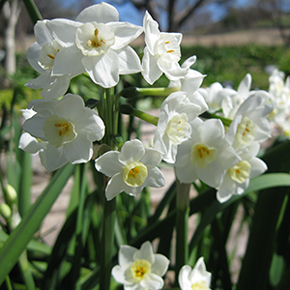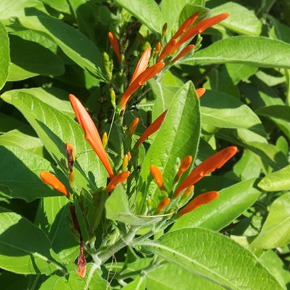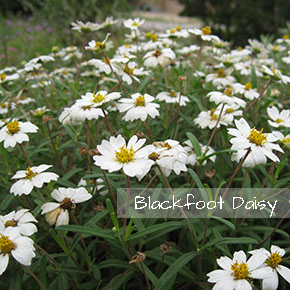If you’re looking for winter blooms, there are many plants — including several that are native — that would make great additions to your winter garden.
Are you the kind of gardener who must have flowers all year? No need to purchase fake flowers. With a little knowledge, you can have flowers this winter!
Paperwhites

Many of us are familiar with the classical Greek myth of Narcissus, the handsome young man who fell in love with his reflection. Did you know Narcissus is also the name of a genus of plants that includes all varieties of paperwhites, daffodils and jonquils?
The specific plant that typically does well in central Texas gardens is Narcissus papyraceus, a Mediterranean native. It has small, cheery and fragrant blooms borne upon 12-15 inch slender, green stems. Bulbs can be purchased at your local nursery and nearby hardware stores. Plant in well-drained soil in a sunny location with the green shoots barely peeking out of the soil surface. The climate of Texas is similar to the Mediterranean climate, so be careful not to overwater or over-pamper this little beauty. Blooms should appear a few weeks after planting. After the flowers die, the bulbs go dormant for the hot months, but will re-sprout in subsequent winters. Paperwhites do naturalize in central Texas so it’s important to be aware of this fact when tending the garden.
If you’re more of an indoor person, you can still enjoy the beauty and fragrance of N. papyraceus. Paperwhite bulbs can be planted in a decorative planter filled with potting soil. Similar to the planting guidelines mentioned above, let the green shoots poke through the soil and thoroughly water. You can expect blooms within 4-6 weeks. These plants make a great gift and can be purchased as a set that includes soil, bulbs and a pot to plant them in.
Mexican Honeysuckle

Justicia spicigera, commonly known as Mexican honeysuckle, is a winter time beauty native to Honduras, Belize, Costa Rica, El Salvador, Guatemala, Nicaragua and Mexico. Despite the name, it’s not closely related to the invasive Japanese honeysuckle or our native coral and white honeysuckle. This plant is in the Acanthus family and more closely related to our native flame acanthus and ruellia. Plant this perennial during the winter months to encourage a strong root system. Mexican honeysuckle prefers partial shade and well-drained soil, it will grow to an average height and width of 3-4 feet and can be cut back in late winter to maintain a more compact form. The bright orange, tube-like flowers are a delight for nectar-seeking hummingbirds.
Native Winter Bloomers

In central Texas we usually have mild winters, some winters are milder than others. There are many native plants that may catch your eye this winter. Make note of them as these species can be great additions to your garden. I’ve observed Wright’s skullcap, Dahlberg daisy, mealy blue sage, Turk’s cap, native lantana, Gregg’s mistflower and blackfoot daisy flowering in the coldest months of winter. Don’t forget that many warm-season, native bunch grasses look great all winter by providing texture in the garden. Utilize grasses such as little bluestem, Lindheimer’s muhly, yellow Indian grass, Gulf muhly, etc. for their benefit to wildlife and aesthetic appeal.
You may even consider some cool-season grasses in your garden such as Canada wild rye, Texas winter grass and melic grass. All of these grasses are quite beautiful and will be green and blooming when many others are fading.




